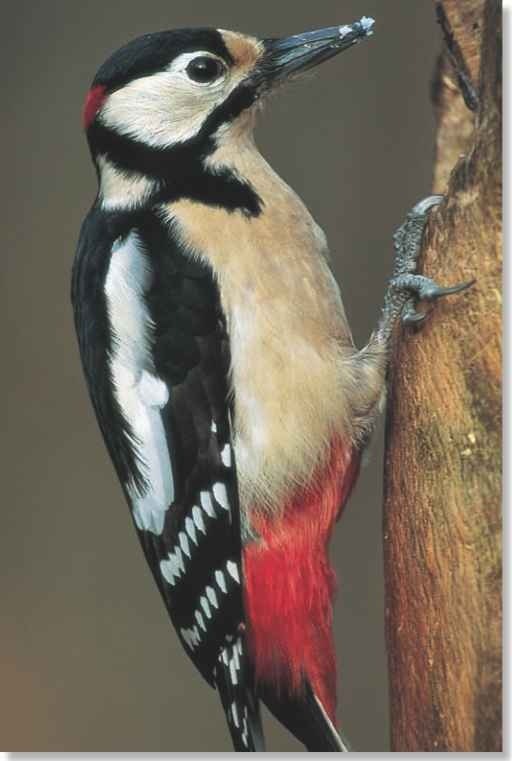ORDER
Piciform.es
FAMILY
Picidae
GENUS & SPECIES
KEY FEATURES
Male makes a loud drumming noise to attract a mate and f proclaim his territory
• Beak is used like a combined hammer and chisel to drill into trees and branches and carve out deep nest holes
• Skull has strong bone structure and shock-absorbing cartilage around the bill to protect the brain and other organs when hammering
WHERE IN THE WORLD?
Widespread through Europe and Asia; absent from Ireland and the northernmost reaches of Scandinavia and Scotland; present where there are trees with enough growth to accommodate nest holes
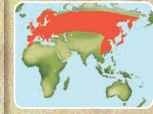
Lifecycle
Most invertebrate-eating birds migrate to warmer climates in winter, but the great spotted woodpecker stays in its territory, where its diet of insect larvae is just beneath the bark.
Habitat
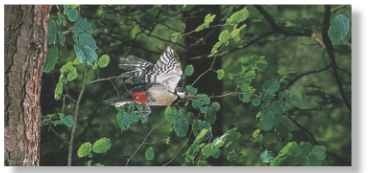
A Touring the treetops Broadleaf, open woodland is the preferred habitat.
Within its range, the great spotted woodpecker can live in virtually any habitat that has mature and dying trees with sufficient trunk girth for nest holes. Boreal forests, temperate woodlands and alpine forests up to an altitude of 6,600′ all support populations.The great spotted woodpecker favors deciduous, conifer and mixed woodlands. In agricultural areas, it inhabits tree-lined hedgerows linking small woods.
The great spotted woodpecker opens the closed flower heads of thistles and other flowers to eat the insects inside.
When drumming, the woodpecker’s bill hits the wood at a rate of 18 times per second. It performs thousands of these violent head blows every day while searching for food and building its nest.
Breeding
In February, before the onset of the breeding season, the male woodpecker drums to signal for a mate. Selecting a hollow tree or dead branch with promising resonant qualities, he taps rapidly on the bark with his bill, making a rattlelike drum roll that is startlingly loud and carries for a considerable distance through the woodland.
Both adults carve out a nest by hammering and chiseling into a tree trunk The nest chamber has an entrance hole at least 10′ above the ground. A short tunnel opens into a pear-shaped cavity 10-12″ deep. The female lays up to seven glossy-white eggs in the dark chamber Parents take turns incubating the clutch and later feeding the grayish, red-capped fledglings. The young leave after three weeks, and attain adult plumage by fall. A pair raises one brood each summer, and may return to the nest if it hasn’t been taken over by starlings or owls.
Pick a peck The fledglings grow rapidly on a protein-rich diet of insect larvae.
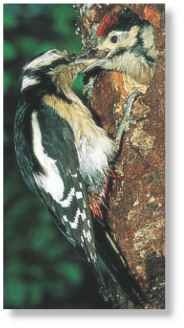
Behavior
The great spotted woodpecker spends much of its time foraging on tree trunks and in the canopy. It’s easily identified by its call or the sound of the male drumming. The call is loud, harsh and explosive; the bird utters it while at rest or when flying.
The great spotted woodpecker is a resident bird; it abandons its territory only when food is scarce. Information from ringed birds has revealed that one woodpecker remained in its 63-acre territory for six years.
During disputes with rivals, the male utters a harsh chatter with a long trill. He drums on branches all year-round to proclaim his territory. Each male has his own drumming sequence and stops to listen to the replies of males nearby.
► Stalwart guardian The woodpecker guards its territory jealously, keeping watch over sites that are suitable for breeding.
Conservation
Great spotted woodpeckers in western Europe have increased over the past 20 years and are now stable, partly as a result of proper forest management. The species has extended its range, spreading north in Britain, Belgium and in the boreal forests of Finland. It is relatively safe due to its ability to adapt to new habitats and foods.
Food & hunting
Ever adaptable, the great spotted woodpecker has a varied diet, feeding on insects and their larvae, as well as spiders. During winter, when animal food may be scarce, it also feeds on fruit, nuts, seeds and other plant material.
The woodpecker flies to the base of a tree and spirals up the trunk in short hops, looking for food. To find larvae buried inside trees, it taps the trunk and listens for a hollow ring that identifies a grub’s tunnel. A few pecks expose the tunnel, and it hooks the grub with the spiky tip of its tongue.
Great spotted woodpeckers also use cracks in the bark to store food, and as “vices” to hold fir cones and nuts while it hammers them open. It also takes other birds’ nestlings.
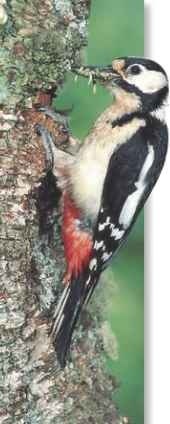
cone hotline
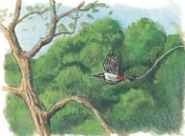
Roller-coaster…
The great spotted woodpecker has an undulating flight, most often seen in open woodland during the spring breeding season.
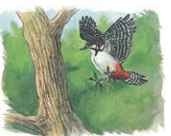
Pull up…
It swoops to make a landing, braking by spreading its wings and tail and bringing up its feet for the touchdown.
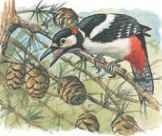
Let’s twist again…
Pine, larch and spruce cones are rich sources of seeds. To pick a cone, the-woodpecker pecks at the stalk or twists it firmly.
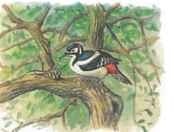
Drum solo
Carrying the cone to another tree, the bird wedges it into the bark, securing it as if in a vice. It is now free to peck out the seeds.

PROFILE
Great Spotted Woodpecker
Solid and strong, the great spotted woodpecker is perfectly adapted to life as a percussion drill for nest-building and searching tree trunks for food.
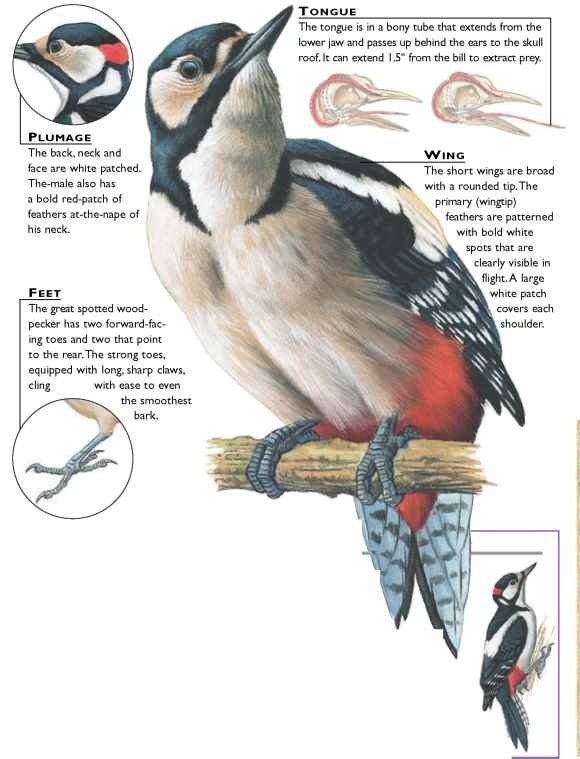
Great spotted woodpecker
Creature comparisons
The Nubian woodpecker (Campethera nubica) has olive-gray upperparts with small, yellowish spots. Its underparts are white with black spots, and the nape of the neck is bright red.The male has red feathers over his crown and a red stripe under each eye. At 7″, this bird is smaller than the great spotted woodpecker
The Nubian woodpecker is widespread in Sudan, Uganda, Kenya and Tanzania, living in open bush country and thorny woodlands. Like its relative, it taps fruits of the baobab tree to induce ants to emerge, which it then scoops up with its long, sticky tongue.

Nubian woodpecker
| VITAL | |
| STATISTICS | |
| Weight | 2.5-3.5 oz. |
| Length | 8.8-9.2″ |
| ‘WlNGSPAN | 13.5-15.5″ |
| Breeding Season | April-July |
| Number of Eggs | 4-7 |
| Incubations Period | 10-13 days |
| Fledging Period | 20-24 days |
| Breeding Interval | 1 year |
| Typical Diet | Insects, wood-boring larvae; spiders, worms, mollusks; nuts, seeds, fruits, sap; nestlings and eggs of other birds |
| Lifespan | Up to 11 years in the wild |
RELATED SPECIES
• The family is divided into 3 subfamilies. Woodpeckers belong to the subfamily Picinae, which has 169 species; it’s represented in Europe, U.S., Africa and Asia. There are 2 wryneck species in the subfamily Jynginae. Wrynecks are small, brown, ground-feeding birds in Europe, Africa and Asia. In the subfamily Picumninae are 29 species of piculet, which inhabit tropical America, Africa and Asia.
